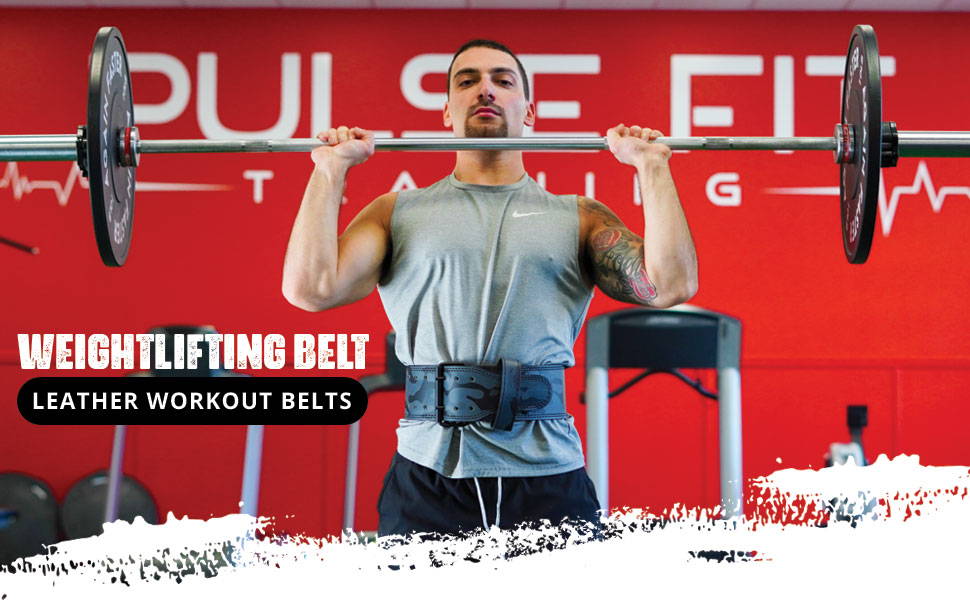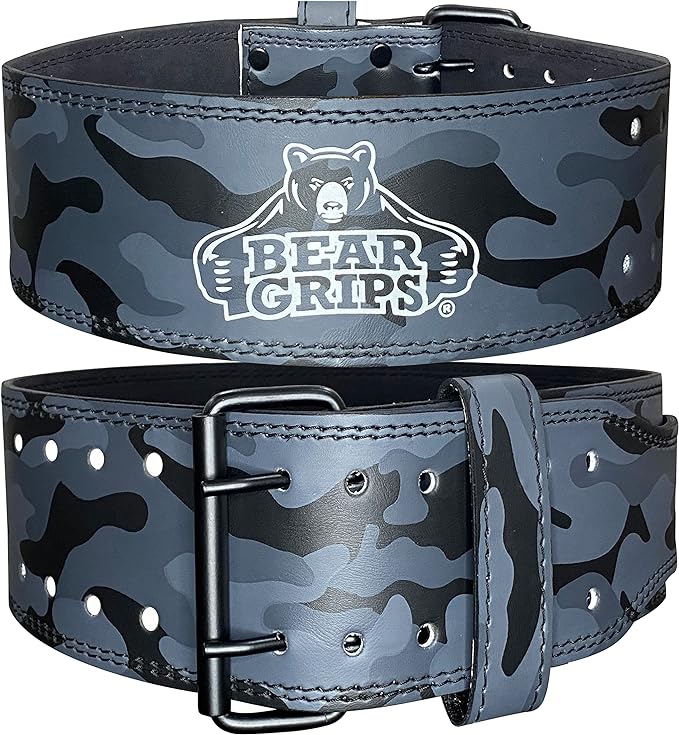
Top Weight Lifting Belt Benefits
Share
Wearing a weightlifting belt can provide several benefits, including enhancing workout performance, increasing safety, and improving spinal support. The belt reduces stress on the lower back by compressing the abdominal cavity, increasing intra-abdominal pressure (IAP), and providing more support to the lower back. It also prevents back hyperextension during overhead lifts by forming a rigid wall around the lower torso.
Additionally, wearing a belt can improve awareness of back position and activate the necessary muscles for good posture. Choosing the right type of weightlifting belt, such as a powerlifting belt or bodybuilding belt, is important for optimal support during weightlifting exercises.
Key Takeaways:
- Weightlifting belts enhance workout performance.
- They increase safety by reducing stress on the lower back.
- Weightlifting belts provide improved spinal support.
- Belts prevent back hyperextension during overhead lifts.
- Choosing the right belt type is crucial for optimal support.
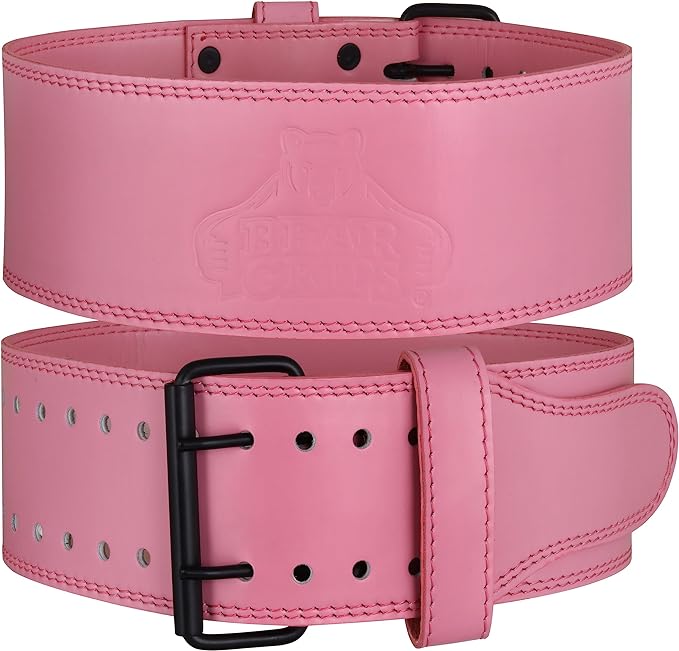
The Purpose of a Weightlifting Belt
The primary purpose of a weightlifting belt is to reduce stress on the lower back and prevent back hyperextension.
When performing weightlifting exercises, such as squats and deadlifts, the weight is supported by the lifter's back. This places a significant amount of stress on the lower back, which can lead to injuries and discomfort. By wearing a weightlifting belt, the lifter can compress the abdominal cavity, increasing intra-abdominal pressure (IAP) and providing support in front of the bones of the lower back. This effectively reduces low back stress and minimizes the risk of injury.
In addition to reducing stress on the lower back, a weightlifting belt forms a rigid wall around the lower torso. This limits back movement, sideward bending, and twisting, preventing back hyperextension during lifting exercises. Hyperextension can strain the back muscles and lead to potential injuries. The belt acts as a stabilizer, providing additional support to the spine and promoting proper lifting technique.
To fully benefit from a weightlifting belt, it's important to wear it tightly during maximal or submaximal lifts and exercises that may cause the back to hyperextend. This ensures optimal support and stability. However, between sets, it's recommended to loosen the belt to allow blood pressure to return to normal.
Overall, a weightlifting belt is a valuable tool for weightlifters and strength athletes, as it helps reduce stress on the lower back and prevent back hyperextension. By promoting proper lifting technique and providing additional support to the spine, a weightlifting belt can enhance performance and minimize the risk of injuries.
Pros and Cons of Weightlifting Belts
| Pros | Cons |
|---|---|
| Reduced stress on the lower back | Potential dependence on the belt |
| Prevention of back hyperextension | Possible decrease in abdominal muscle activation |
| Improved lifting technique | May increase blood pressure |
| Increased support and stability | Less core development without proper core exercises |
Best Exercises for Using a Weightlifting Belt
While weightlifting belts can be beneficial for various exercises, there are certain exercises where they are particularly useful. These include the deadlift, overhead press, clean and jerk, barbell bent over rows, bench press, and barbell squat.
The deadlift is a full-body exercise that can benefit from the stability and back support provided by a weightlifting belt. By wearing a belt, you can improve your form and maintain proper spinal alignment, reducing the risk of injury and allowing you to lift heavier weights.
The overhead press and clean and jerk require shoulder strength and stability, which can be improved by wearing a weightlifting belt. The belt helps to brace the core and create intra-abdominal pressure, providing a solid base for your upper body movements.
Barbell bent over rows target the back and biceps, and can benefit from the added support and stability a weightlifting belt provides. It helps to maintain a neutral spine position and prevents excessive back rounding during the exercise.
Bench press exercises, especially when using heavy weights, can place extra stress on the core muscles. Wearing a weightlifting belt can help stabilize the torso, allowing you to generate more power and lift with better control.
The barbell squat, both back and front, is a demanding lower body exercise that can benefit from the increased stability and support provided by a weightlifting belt. It helps to maintain a more upright posture and reduces stress on the lower back.
By incorporating a weightlifting belt into these exercises, you can enhance your performance, maintain proper form, and reduce the risk of injuries. However, it is important to note that a weightlifting belt should not be used as a crutch and should not replace proper technique and strength-building exercises.
Benefits of Using a Weightlifting Belt
Using a weightlifting belt provides several benefits that can enhance your lifting performance and reduce the risk of injury. Let's explore the advantages of incorporating a weightlifting belt into your training regimen:
Increased Stability
A weightlifting belt provides additional stability and support for your spine during heavy lifts. By stabilizing your core, the belt helps distribute the load evenly and reduces stress on your lower back, allowing you to maintain a more upright posture.
Reduced Risk of Injury
Wearing a weightlifting belt can help minimize the risk of back injuries. The belt acts as a support system, keeping your spine aligned and reducing excessive flexion and extension that can lead to strains or sprains. It provides a mechanical advantage that allows you to lift with confidence and minimize the risk of sudden movements or improper form.
Improved Lifting Technique
A weightlifting belt promotes proper lifting technique by encouraging proper posture and muscle activation. It reminds you to engage your core muscles, including the abdominal and lower back muscles, which are essential for maintaining stability and generating power. By reinforcing good form, the belt can help you lift more effectively and efficiently.
Increased Lifting Power
With the added stability and support provided by a weightlifting belt, you can tap into your full lifting potential. The belt stabilizes the pelvis and hips, allowing you to generate greater force and power during your lifts. Increased stability translates to improved performance and the ability to handle heavier weights.
Solid research supports the benefits of weightlifting belts. For example, studies have shown that wearing a belt during exercises like squats can increase intra-abdominal pressure, reduce spinal flexion and extension, and increase muscle activity in the abdominal and lower back muscles, ultimately enhancing performance and facilitating muscle growth.
Remember, while weightlifting belts can be beneficial, they are not a substitute for sound training techniques and adequate warm-up routines. The belt should be used as a tool to complement proper form, technique, and strength development. It's important to select a belt that fits well and to use it appropriately for maximal effectiveness.
Now that we've explored the benefits of using a weightlifting belt, let's dive into how it can contribute to core development in the next section.
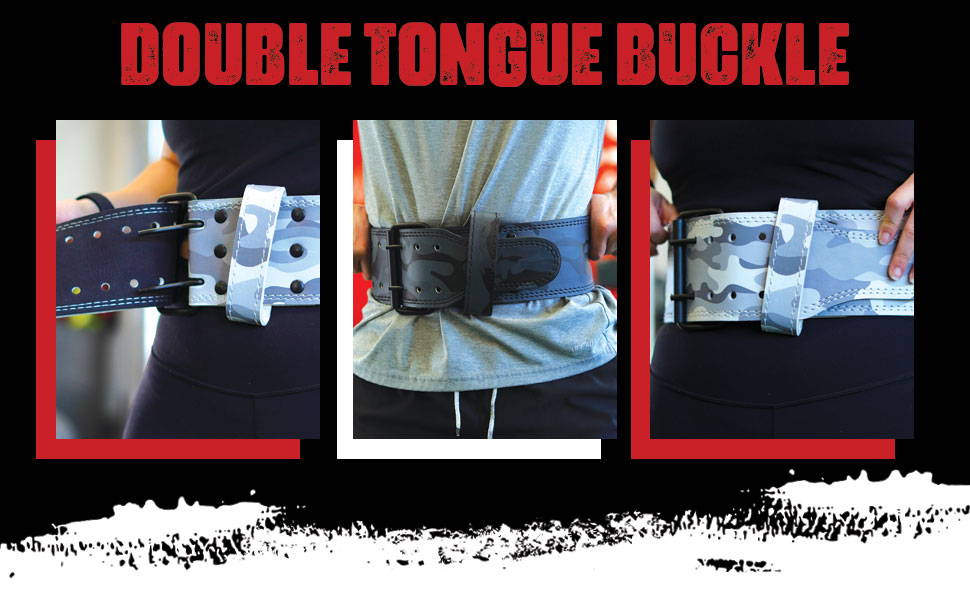
Weightlifting Belts and Core Development
Contrary to popular belief, wearing a weightlifting belt can actually contribute to core development rather than hindering it. Research suggests that wearing a belt increases the muscle activity of the rectus abdominis and can enhance abdominal muscle engagement during weightlifting exercises.
While weightlifting belts provide external support to the core, they should not replace the need for core work, stabilization, and proper exercise technique. It is important not to rely too heavily on the belt during training and to maintain proper bracing and breathing techniques to effectively utilize its benefits.
| Benefit | Explanation |
|---|---|
| Increased Muscle Activity | Research suggests that wearing a weightlifting belt increases the muscle activity of the rectus abdominis, leading to enhanced abdominal muscle engagement. |
| External Support | Weightlifting belts provide external support to the core, helping stabilize the spine and reducing stress on the abdominal muscles. |
| Proper Technique | While a weightlifting belt can assist in maintaining proper form, it is crucial to focus on core work, stabilization, and maintaining good exercise technique. |
Types of Weightlifting Belts
When it comes to weightlifting belts, there are several types to choose from, each catering to different needs and preferences. Whether you're a powerlifter, bodybuilder, or just looking for extra support during your workouts, selecting the right type of weightlifting belt is crucial. Let's take a closer look at some of the most common types of weightlifting belts available on the market:
1. Powerlifting Belts
Powerlifting belts are designed to provide maximum support and stability during heavy lifting. They are typically the same width all the way around, offering consistent support for the core and preventing back hyperextension and twisting. Powerlifting belts are ideal for movements like squats, deadlifts, and overhead presses, where maintaining proper spinal alignment is crucial for performance and safety.
2. Bodybuilding Belts
Bodybuilding belts, also known as traditional belts, may come in different designs and materials. While they offer similar support for the lower back as powerlifting belts, bodybuilding belts often focus more on aesthetics and comfort. They can be a great option for bodybuilders and fitness enthusiasts looking for a belt that combines functionality and style.
3. Velcro Belts
Velcro belts are a convenient alternative to traditional leather belts. They feature a Velcro closure system that makes them easier to put on and remove, saving time and effort. Velcro belts can be especially beneficial for lifters who prefer a more adjustable fit or need to quickly adjust the belt tightness during their workouts.
4. Thicker Belts
Thicker weightlifting belts offer increased support and stability for the spine. These belts typically have a larger width, providing added rigidity and reducing the risk of injury during heavy lifts. If you prioritize maximum support and are involved in heavy compound movements, investing in a thicker weightlifting belt may be a wise choice.
Choosing the right type of weightlifting belt depends on your personal preferences, lifting style, and specific needs. Consider factors such as the exercises you frequently perform, your lifting goals, and the level of support you require. Remember, finding the right weightlifting belt can make a significant difference in your performance and overall lifting experience.
| Type of Weightlifting Belt | Description |
|---|---|
| Powerlifting Belts | Same width all around, preventing back hyperextension and twisting |
| Bodybuilding Belts | Various designs and materials, offering support for the lower back |
| Velcro Belts | Easier to put on and remove with a Velcro closure system |
| Thicker Belts | Provide increased support and stability for heavy lifts |
Proper Usage of Weightlifting Belts
Weightlifting belts should be used sparingly and in specific circumstances to optimize their benefits and prevent potential drawbacks. These belts are most effective when employed during maximal or submaximal lifts that place significant stress on the back, such as squats and deadlifts. Additionally, exercises that have the potential to cause back hyperextension, like the military press, can benefit from the use of a weightlifting belt.

During these lifts, it is crucial to wear the belt tightly to provide optimal support and stability to the spine. The belt's compression on the abdominal cavity increases intra-abdominal pressure (IAP) and reduces stress on the lower back. However, when resting between sets, it is important to loosen the belt to allow blood pressure to return to normal levels.
On the other hand, weightlifting belts are not necessary for other types of weight training exercises that do not heavily load the spinal erectors or involve fairly light work. Constantly relying on a belt for every exercise can lead to decreased abdominal muscle strength and create dependency on the belt for stability.
Proper usage of weightlifting belts involves understanding the specific circumstances where they are most beneficial and ensuring they are not overused, allowing lifters to maximize their performance while maintaining the strength of their core muscles.
| Maximal or Submaximal Lifts | Exercises Causing Back Hyperextension | Light Work or Low Resistance Exercises |
|---|---|---|
| Squats | Military Press | Isolation Exercises |
| Deadlifts | - | Bodyweight Exercises |
| Weighted Lunges | - | Plyometric Exercises |
Table: Suitable Usage of Weightlifting Belts
Potential Side Effects of Improper Belt Use
Weightlifting belts can be a valuable tool for enhancing performance and safety during workouts. However, improper use of these belts can lead to potential side effects that lifters should be aware of. It is essential to understand the proper usage and limitations of weightlifting belts to avoid any adverse effects on your health and strength development.
Increased Blood Pressure for Individuals with High Blood Pressure or Heart Disease
One potential side effect of wearing a weightlifting belt incorrectly is increased blood pressure. When a tight belt is worn during exercise, especially for prolonged periods, it can further elevate blood pressure levels. This can be especially concerning for individuals who already have high blood pressure or heart disease. Lifters with these conditions should consult with their healthcare professionals before using a weightlifting belt to ensure it is appropriate for their specific circumstances.
Abdominal Muscle Weakness and Impaired Strength Development
A weightlifting belt provides external support to the core muscles, including the abdominal muscles. While this support can be beneficial during heavy lifts, constantly relying on the belt can lead to abdominal muscle weakness over time. The belt inhibits the natural activation and engagement of the abdominal muscles, which are crucial for stabilizing the abdomen. As a result, lifters may experience decreased strength development in the abdominal muscles and increased dependency on the belt for stability.
Caution and Proper Use
It is important to exercise caution when using a weightlifting belt and not solely rely on it for core strength development. Lifters should utilize the belt as a tool to supplement their training and not as a substitute for developing proper core strength and stability. Incorporating exercises that target the abdominal muscles, such as planks and Russian twists, into your training routine can help maintain their strength and functionality.
In conclusion, while weightlifting belts can provide significant benefits when used correctly, improper use can lead to potential side effects. Lifters should be mindful of the risks associated with wearing a belt, especially for individuals with high blood pressure or heart disease. Additionally, it is important to strike a balance between utilizing the belt for enhanced performance and maintaining the strength and functionality of the abdominal muscles. By understanding the proper usage and limitations of weightlifting belts, lifters can optimize their training safely and effectively.
Research Studies on Weightlifting Belts
Several research studies have been conducted to understand the effects of weightlifting belts on various aspects of lifting performance.
These studies have focused on factors such as intra-abdominal pressure (IAP), spinal loading, muscle activity, and one-rep max strength.
One study found that wearing a weightlifting belt can significantly increase intra-abdominal pressure, leading to improved stability and support during heavy lifts.
Another study demonstrated that wearing a weightlifting belt can effectively reduce spinal flexion and extension, minimizing the risk of injury and enhancing lifting technique.
Moreover, research has shown that weightlifting belts can increase muscle activity in the abdominal and lower back muscles, promoting greater strength and efficiency in lifting movements.
Additionally, studies have reported improvements in one-rep max strength when using a weightlifting belt, allowing individuals to lift heavier weights and achieve new personal records.
These research studies provide valuable insights into the benefits and effects of weightlifting belts on lifting performance, emphasizing their role in enhancing intra-abdominal pressure, reducing spinal loading, increasing muscle activity, and improving one-rep max strength.
By incorporating the findings from these studies, lifters can make informed decisions regarding the use of weightlifting belts to optimize their training and achieve their fitness goals.
Using a Weightlifting Belt Properly
Maximizing the benefits of a weightlifting belt requires proper usage. The following guidelines will help you use your weightlifting belt effectively:
- Proper Fit: Ensure that your weightlifting belt fits well. It should be tight enough to provide support but not so tight that it restricts breathing or movement. A snug fit will help maintain stability and prevent the belt from shifting during lifts.
- Breathing Techniques: Utilize proper breathing techniques while wearing the weightlifting belt. The Valsalva maneuver is a commonly used technique in which you take a deep breath and hold it while lifting. This increases intra-abdominal pressure, stabilizes the spine, and enhances core engagement. Remember to exhale after completing the lift.
- Appropriate Exercises: Focus on using the weightlifting belt for exercises that place significant stress on the spine, such as squats, deadlifts, cleans, snatches, and bent-over rows. These exercises benefit greatly from the additional stability and support provided by the belt.
- Maintain Good Posture: While wearing the weightlifting belt, it's essential to maintain proper posture throughout your lifts. This includes keeping your back straight, shoulders back, and core engaged. The belt should assist in supporting your natural lifting posture, not compensate for poor form.
By following these guidelines, you can ensure that you are using your weightlifting belt properly, maximizing its benefits, and minimizing the risk of injury.
Weightlifting Belts and Spinal Stability
Weightlifting belts play a crucial role in enhancing spinal stability during heavy lifts. By increasing intra-abdominal pressure (IAP) and providing external support to the core muscles, weightlifting belts help stabilize the spine and reduce spinal flexion and extension. This leads to improved biomechanics and reduced strain on the lower back.
When wearing a weightlifting belt, the increased stability allows lifters to perform exercises with greater control and confidence. By promoting proper lifting technique and muscle activation, weightlifting belts help minimize the risk of back injuries during intense training sessions.
Using a weightlifting belt can provide the necessary support to lift heavy weights while protecting the spine from excessive stress. The belt acts as a powerful tool for maintaining proper alignment, which is crucial for avoiding spinal injuries and ensuring safe and effective workouts.
Weightlifting belts are designed to provide targeted support to specific areas of the body, particularly the lower back. By offering external reinforcement, the belts help keep the spine in a neutral position, reducing the risk of injury.
Wearing a weightlifting belt not only protects the lifter's spine but also enhances overall lifting performance. With improved stability, lifters can focus on executing exercises with proper form and technique, optimizing their training results.
Reduced Spinal Flexion and Extension
Weightlifting belts help limit unnecessary movements, such as spinal flexion and extension, during heavy lifts. This restriction helps maintain a stable and aligned spine, reducing the chance of injury or strain.
By reducing spinal flexion and extension, weightlifting belts enhance the efficiency and effectiveness of each lift, allowing lifters to maximize their strength and power.
The following table provides a comparison of spinal flexion and extension with and without a weightlifting belt:
| With Weightlifting Belt | Without Weightlifting Belt | |
|---|---|---|
| Spinal Flexion | Reduced | Increased |
| Spinal Extension | Reduced | Increased |
The table clearly illustrates how weightlifting belts contribute to reduced spinal flexion and extension, resulting in a more stable and secure lifting experience.
Implementing weightlifting belts into training sessions can significantly enhance spinal stability, reduce the risk of injuries, and improve overall lift performance. It is important for lifters to select high-quality weightlifting belts and utilize them properly to experience the full benefits.
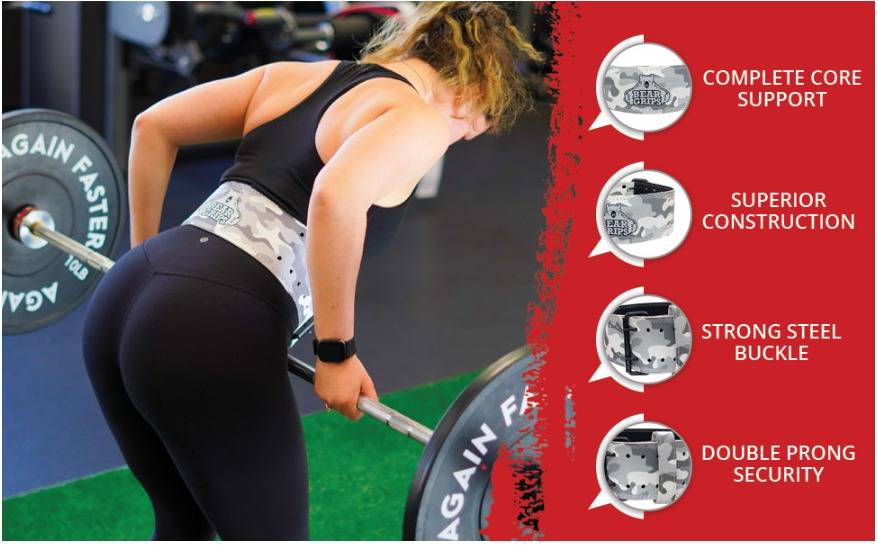
Conclusion
Weightlifting belts offer a host of benefits that can significantly enhance a lifter's workout performance, increase safety, and provide improved spinal support. By wearing a weightlifting belt, individuals can reduce stress on their lower back, effectively prevent back hyperextension, and promote proper lifting technique. These belts are designed to contribute to overall lifting performance while minimizing the risk of injuries.
It is crucial to use weightlifting belts sparingly and in specific circumstances, such as during maximal lifts or exercises that may lead to back hyperextension. Adhering to proper usage guidelines, including achieving the right fit and employing appropriate breathing techniques, is essential. This enables lifters to maximize the advantages of weightlifting belts and optimize their workout performance, safety, and spinal support.
By incorporating weightlifting belts into their training routines, individuals can experience enhanced stability and support, leading to improved biomechanics and reduced spinal flexion and extension. This, in turn, reduces strain on the lower back and minimizes the risk of back injuries. Weightlifting belts play a critical role in providing external support to the core muscles, fostering spinal stability, and increasing awareness of proper lifting posture. They are an invaluable tool for anyone looking to bolster their workout performance while ensuring the utmost safety and support for their spine.
Get your hands on the Bear Grips Weight Lifting Belt today!
Shop at Amazon.com Now!
FAQ
What are the benefits of wearing a weightlifting belt?
Wearing a weightlifting belt can enhance workout performance, increase safety, and provide improved spinal support.
How does a weightlifting belt reduce stress on the lower back?
The weightlifting belt compresses the abdominal cavity, increases intra-abdominal pressure (IAP), and provides more support to the lower back, reducing stress during upright lifts.
What exercises are best for using a weightlifting belt?
Weightlifting belts are particularly useful for exercises such as deadlifts, overhead press, clean and jerk, barbell bent over rows, bench press, and barbell squats.
What are the benefits of using a weightlifting belt?
Benefits of using a weightlifting belt include increased stability, reduced risk of injury, improved lifting technique, and increased lifting power.
Can weightlifting belts help with core development?
Contrary to popular belief, weightlifting belts can actually enhance abdominal muscle engagement during weightlifting exercises and contribute to core development.
What types of weightlifting belts are available?
Common types of weightlifting belts include powerlifting belts, bodybuilding belts, Velcro belts, and thicker belts for increased support to the spine.
How should weightlifting belts be used properly?
Weightlifting belts should be used for maximal or submaximal lifts and exercises that may cause the back to hyperextend, tightened during these lifts but loosened between sets.
Are there any potential side effects of improper weightlifting belt use?
Improper use of weightlifting belts can lead to increased blood pressure, decreased abdominal muscle strength, and dependency on the belt for stability.
What do research studies say about weightlifting belts?
Research studies have shown that weightlifting belts can increase intra-abdominal pressure, reduce spinal flexion and extension, and increase muscle activity, enhancing lifting performance.
How should weightlifting belts be used properly for optimal benefits?
Proper usage of weightlifting belts involves ensuring a proper fit, using correct breathing techniques like the Valsalva maneuver, and maintaining good posture and muscle engagement while wearing the belt.
How do weightlifting belts contribute to spinal stability?
Weightlifting belts enhance spinal stability by increasing intra-abdominal pressure, providing external support to the core muscles, and reducing spinal flexion and extension.


